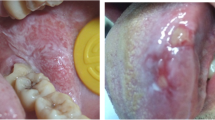Abstract
Long-term use of prosthesis is the most important risk factor for the colonization of Candida species on the mucosal surfaces, which can lead to the development of denture-related stomatitis (DRS). Some individuals wearing prosthesis develop DRS and others do not. C. albicans strains isolated from both groups were genotypically compared. The purpose of this study was to determine whether the strain causing prosthesis stomatitis was different from the other strains genotypically. The study included 90 individuals wearing different prostheses and 20 control individuals with natural teeth. In the study 109 C. albicans strains were used which were isolated from the saliva samples and the mucosal surfaces of the tongues and palates of 51 individuals and then defined phenotypically. Phenotypic diagnosis of the isolates was genotypically verified by using species-specific PCR. For molecular typing, repetitive extragenic palindromic sequence polymerase chain reaction (REP-PCR) was employed. The results of the study revealed that REP-PCR had the capability to separate 109 C. albicans strains and six reference strains into 44 genotypes. Whereas C. albicans strains showed heterogenic distribution, C. albicans strains isolated from the individuals suffering from prosthesis stomatitis showed no specific genotypes. REP-PCR is a simple, fast and low-cost method and helped work on a great number of samples.






Similar content being viewed by others
References
Budtz-Jorgensen E (2000) Ecology of Candida-associated denture stomatitis. Microb Ecol Health Dis 12:170–185
Darwazeh AMG, Al-Refai S, Al-Mojawel S (2001) Isolation of Candida species from the oral cavity and fingertips of complete denture wearers. J Proshet Dent 86:420–423
Pires FR, Santos EBD, Bonan PR, Almeida OP (2002) Denture stomatitis and salivary Candida in Brazilian edentulous patients. J Oral Rehabil 29:1115–1119
Samaranayake LP, Cheung LK, Samaranayake YT (2002) Candidiasis and other fungal diseases of the mouth. Dermatol Ther 15:251–269
Soll DR (2000) The ins and outs of DNA fingerprinting the infectious fungi. Clin Microbiol Rev 13:332–370
Dassanayake RS, Samaranayake LP (2003) Amplification-based nucleic acid scanning techniques to assess genetic polymorphism in Candida. Crit Rev Microbiol 54:249–258
Stachie RF, Healy M (2006) Molecular strain typing using repetitive sequence-based PCR. In: Tang, YW, Strattan, CW (Eds), Advanced techniques in diagnostic microbiology. Springer Science + Business Media, LLC
Olive DM, Pamela B (1999) Principles and applications of methods for DNA-based typing of microbial organisms. J Clin Microbiol 37:1661–1669
Redkar RJ, Dube MP, McCleskey FK, Rinaldi MG, Delvecchio VG (1996) DNA fingerprinting of Candida rugosa via repetitive sequenced-based PCR. J Clin Microbiol 34:1677–1681
Liu D, Coloe S, Baird R, Pederson J (2000) Rapid mini-preparation of fungal DNA for PCR. J Clin Microbiol 38:471
Olgun A, Topal A, Temizkan G, Yılmazer S (1998) Methods used in molecular biology. Research and application center of biotechnology and genetic engineering. Publication no. 1, BİYOGEM (in Turkish)
Mannarelli BM, Kurtzman CP (1998) Rapid Identification of Candida albicans and other human pathogenic yeast by using short oligonuclotides in a PCR. J Clin Microbiol 36:1634–1641
Abaci O, Haliki-Uztan A, Ates M (2008) Specific identification of Candida albicans and Candida dubliniensis by PCR using species-specific primers. Ann Microbiol 58(2):325–331
SPSS 11.0 for Windows. SPSS Inc., Chicago, IL, USA
Abaci O, Haliki-Uztan A, Ozturk B, Toksavul S, Ulusoy M, Boyacioglu H (2010) Determining Candida spp. incidence in denture wearers. Mycopathologia. doi:10.1007/s11046-010-9275-8
Senpuku H, Sogame A, Inoshitu E, Tsuha Y, Miyazaki H, Hanada N (2003) Systemic diseases in association with microbial species in oral biofilm from elderly requiring care. Gerontology 49(5):301–309
Reiss E et al (1998) Molecular diagnosis and epidemiology of fungal infections. Med Mycol 36(suppl 1):249–257
Hossain H, Ansari F, Schulz-Weidner N, Wetzel W-E, Chakraborty T, Domann E (2003) Clonal Identity of Candida albicans in the oral cavity and the gastrointestinal tract of pre-school children. Oral Microbiol Immunol 18:302–308
Samaranayeke YH, Samaranayeke LP, Yau JYY, Dassanayake RS, Li TKL, Anil S (2003) Phenotyping diversity of oral C.albicans isolated on single and sequential visits in an HIV-infected Chinese cohort. APMIS 111:329–337
Waltimo TMT, Dassanayake RS, Ørstavik D, Haapasalo MPP, Samaranayeke LP (2001) Phenotypes and randomly amplified polymorphic DNA profiles of Candida albicans isolates from root canal infections in a Finnish population. Oral Microbiol Immunol 16:106–112
Leung KW, Dassanayake RS, Yau JYY, Jin LJ, Yam WC, Samaranayake LP (2000) Oral colonization, phenotypic, and genotypic profiles of Candida species in irradiated dentate, xerostomic nasopharyngeal carcinoma survivors. J Clin Microbiol 38(6):2219–2226
Xu J, Ramos AR, Vilgalys R, Mitchell TG (2000) Clonal and spotaneous origins of fluconazole resistance in Candida albicans. J Clin Microbiol 38:1214–1220
Gil-Lamaignere C, Roilides E, Hacker J, Müller F-MC (2003) Molecular typing for fungi—a critical review of the possibilities and limitations of current and future methods. Clin Microbiol Infect 9:172–185
Cross LJ, Williams DW, Sweeney CP, Jackson MS, Lewis MAO, Bagg J (2004) Evaluation of the recurrence of denture stomatitis and Candida colonization in a small group of patients who received itraconazole. Oral Surg Oral Med Oral Pathol Oral Radiol Edod 97:351–358
Mathaba LT, Davies G, Warmington JR (1995) The genotyping relationship of Candida albicans strains isolated from the oral cavity of patients with denture stomatitis. J Med Microbiol 42:372–379
Pires-Gonçalves RH, Miranda ET, Baeza LC, Matsumoto MT, Zaia JE, Mendes G (2007) Genetic relatedness of commensal strains of Candida albicans carried in the oral cavity of patients’ dental prosthesis users in Brazil. Mycopathologia 164:255–263
Author information
Authors and Affiliations
Corresponding author
Rights and permissions
About this article
Cite this article
Abaci, O., Haliki-Uztan, A., Ozturk, B. et al. Molecular typing of Candida albicans strains isolated from denture wearers by repetitive sequence-based PCR. Eur J Clin Microbiol Infect Dis 30, 141–149 (2011). https://doi.org/10.1007/s10096-010-1062-4
Received:
Accepted:
Published:
Issue Date:
DOI: https://doi.org/10.1007/s10096-010-1062-4




